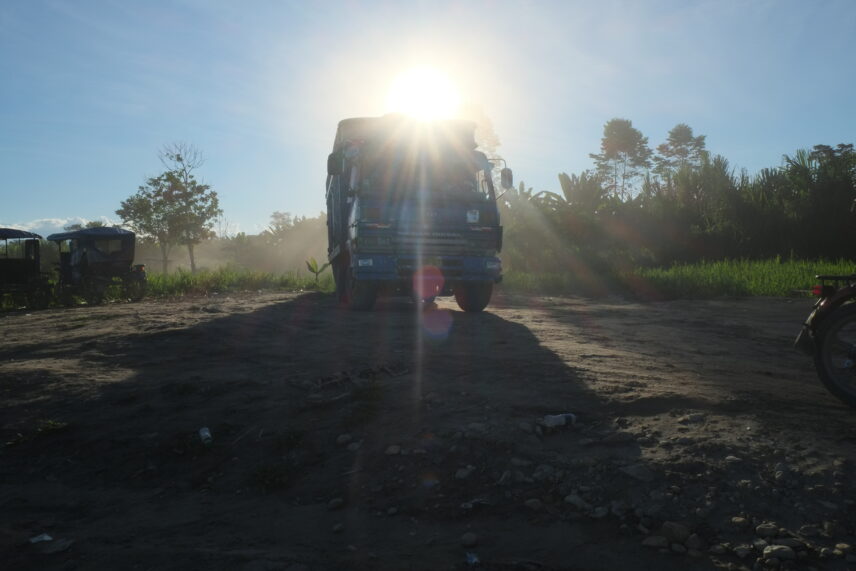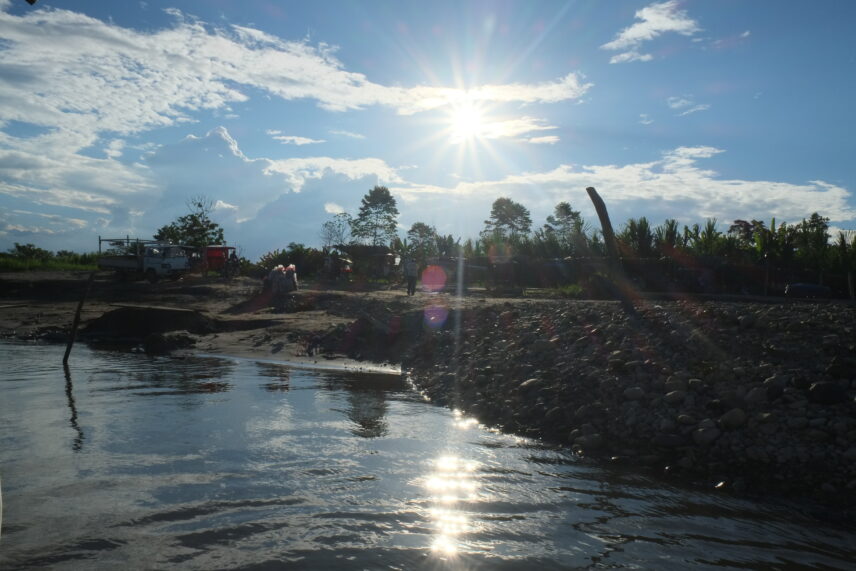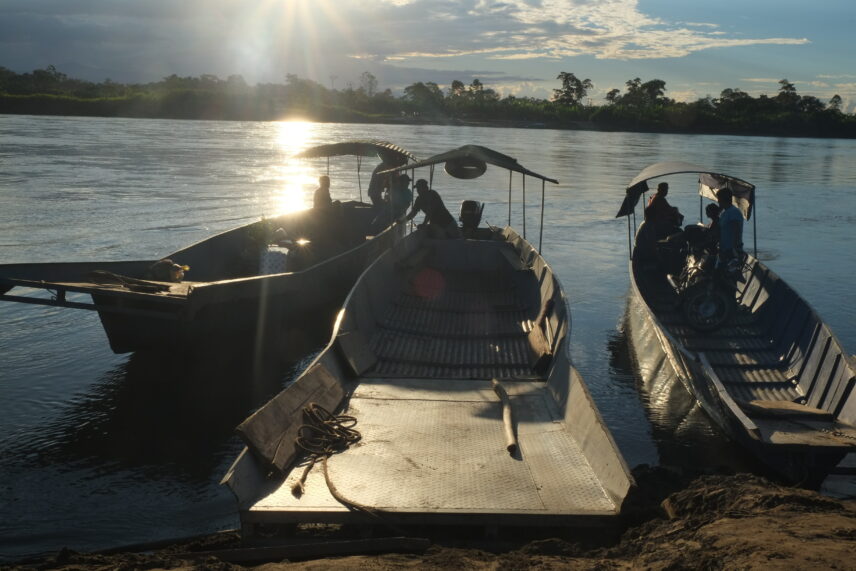Article begins
Tal vez describir una toma fotográfica es simplemente bosquejar las relaciones entre lo que se ve y lo que queda en tinieblas. Tal vez es sólo entrar en ese movimiento que ondea entre constatar lo que está patente y extenderse hacia lo que no aparece dentro del encuadre. La descripción requiere un buen tiempo para mirar… y luego otro más para contemplar. Si bien tomar ese tiempo no garantiza hallar algo. Si bien no promete compensar el esfuerzo.
Tomar ese tiempo se llama lujo… y este sol que destella, que se posa sobre el techo de un camión. Mancha blanca amarilla con una aureola que la rodea, así ligera, cómo atropella, cómo se precipita hacia la mirada, retándola a desviarse. Un resplandor que se explaya en ángulos cortantes, en rayos punzantes que ocupan el aire para trazar sus líneas hacia el suelo. Cómo se adelanta el más fuerte, penetrando en su descenso las tangentes de dos pequeñas figuras hexagonales. Éstas en sí no son más que huellas y reflejos que el rayo más fuerte solicita, arranca, y despoja de la misma máquina fotográfica. Cómo amenaza con romper la ilusión, con partir esa superficie invisible en dos lados, pero también en acrecentar sus capas en tres y hasta más.

Escogí esta imagen porque quería pensar cómo se impone el sol sobre los terrenos ribereños del Alto Huallaga, una región cocalera del Perú fuertemente golpeada por un conflicto militar entre el grupo maoísta Sendero Luminoso y las fuerzas de seguridad del estado. Tomé la foto a orillas del río Huallaga, un 8 de julio del 2015, durante una de varias estadías de investigación de campo. Me había propuesto seguir las transformaciones de territorio que pudieran notarse después de esa guerra. Quería pensar detenidamente en lo que se escondía en las estelas del conflicto. También quería rastrear hasta qué punto los acontecimientos de ese doloroso pasado podrían palparse aún en el paisaje: los terrenos ribereños que conforman este valle. Cuando saqué la foto, apenas había transcurrido una semana después de que el entonces presidente del Perú, Ollanta Humala, había visitado de modo sorpresivo a un pueblo muy cercano. Ahí Humala anunció el levantamiento definitivo del estado de emergencia, el cual había pendido de manera intermitente sobre el Alto Huallaga desde mediados de la década de los ochenta, cuando Sendero Luminoso empezó a sumar su furia a la violencia que ya reinaba alrededor de la economía de la cocaína, agravada por la represión policial de una supuesta guerra contra las drogas.
Pero ahora, mirando bien atrás, otros reflejos andan: una brillantez que alumbra el polvo, levantado por el movimiento de un camión, que flota aún en el aire. Una neblina de partículas que asciende, perdiéndose en el celeste de un cielo sin espesor, fondo de todos los fondos. Un atardecer, otra vez. Y los mismos rayos que resaltan granos y texturas, iluminan hojas con un verde translúcido hasta un lindero invisible y nada más, donde desisten en su avance hacia las aguas.

Pura tierra y piedra es este lugar donde se cruza hacia el pueblo de Progreso y donde, sobre ellas, sobre tierra y piedra, pasan las llantas de un Nissan Diésel. Recién ha aparecido, llevando carga desde las chacras de la margen izquierda, de retorno nuevamente de Paraíso o de caseríos aledaños, nuevamente rumbo al otro lado. Y entre ese sacar y entrar y ese volver a sacar, y entre olas y orillas llega ahora a parar sobre la ribera. Ahí nuestros caminos se entrelazan. En mi retorno de Paraíso y en mi sin querer pasar todavía, coincidimos.
Más intenso el resplandor, más espesa la oscuridad a sus costados. Aquí el bloque rectangular del camión corta el campo con una sombra grande en la que una botella de plástico y por allá otra más yacen botadas. Dentro de la cabina aguarda un chofer. Ese hombre que apenas se divisa, sentado ahí detrás del timón, esperando a cruzar, a solas con todo lo que le acompaña que no sale a la vista.
Formas de movilidad apuntan a itinerarios, destinos y mundos variados. Dos motocarros vacíos se notan a la extrema izquierda—una rueda de otro sobresale a la derecha—momentáneamente estacionados dentro del sin fin de salidas, esperas y espesuras creado por un sitio de vado. Cada uno con sus propias opacidades y zonas de indeterminación. Un sin fin que también deja huellas, algunas con un marcado sentido histórico. Los motocarros apenas comenzaron a aparecer en el Alto Huallaga a mediados de los años noventa a raíz del colapso del precio de la coca. Ante la extrema contracción de la economía de la droga, muchos jóvenes que antes trabajaban de traqueteros se convirtieron en mototaxistas. Tanto así que veinte años atrás se escuchaba uno que otro relato del traquetero, quien lloró al verse obligado a cortar su moto lineal en dos, con el propósito de separar la rueda posterior y soldar en su lugar un eje lateral, donde agregaría en cada lado una rueda y encima un banquito horizontal para acomodar a los pasajeros.

Siempre el mismo sol, cómo domina, semejante a nada. Cómo quema la piel, esa misma piel que pican los moscos, otro elemento que a lo largo del río recomienda buscar amparo. Los paraguas acá los usan sólo las mujeres, pero más como parasoles o sombrillas. Varones por ser varones optan a ponerse una gorra a lo más. Los botes que ofrecen el servicio de vado llevan ahora techo para proteger a sus pasajeros de los implacables rayos. Y hasta este refugio refleja cambios a la intemperie política tanto obvios como inescrutables, cambios que modifican los vínculos que se estrechan y que se distancian entre este presente que no deja de correr y esos otros pasados que ya no se imponen, cuando el sol no era lo único que te hacía desviar la vista, cuando sabías, de antemano, que por el río era mejor no sostener la mirada con nadie.
The Glare
What if describing a photograph were a matter of simply sketching relations between what can be seen and what remains in the dark. What if describing a photograph entailed entering a movement that swings between confirming the obvious and stretching out to what does not appear within the frame. Description requires a significant interval of time just to look… and then another just to contemplate. Even if that extended tract of time does not guarantee finding anything at all. Even if it does not promise to compensate the effort.
To take that time is called luxury… and this sun that gleams, touches down on the roof of a truck: white yellow stain rounded in halo, soft like that. How roughshod it runs. How it rushes out toward and into the gaze, daring eyes to pull away. A glare shoots at angles that cut, in pointed rays that occupy the air to better trace its lines down to the ground. See how the strongest one moves ahead, piercing tangents of two small hexagonal figures in its descent. Those geometrical shapes are nothing more than tracks and reflections that the strongest ray solicits, rips, and dispossesses from the camera itself. See how that ray threatens the illusion, to dispel it, by splitting an invisible surface into two, but also by multiplying those layers into three and more.

I chose this image because I wanted to think about how the sun imposes itself on the riverine terrains of the Upper Huallaga, a coca-growing region of Peru, deeply marked by a military conflict waged between the Maoist Shining Path and the security forces of the state. I took this photo on July 8, 2015, on the banks of the Río Huallaga during one of several stints of fieldwork. I was attempting to follow the transformations of territory in the aftermath of that war. I wanted to think through what was hidden in the wakes of the conflict, but I also wanted to localize the extent to which events of that grievous past might still be sensed in the landscape, in the riverine terrains that make up this valley. When I took this photo, little more than a week had transpired since the then President Ollanta Humala had made a surprise visit to a nearby hamlet. There Humala had announced the definitive end of the state of emergency, which had hung over the Alto Huallaga, if sporadically, since the mid-1980s, ever since Shining Path began to add its fury to the violence, which was then permeating the cocaine economy, aggravated all the more by police repression stemming from a so-called war on drugs.
Yet now, looking deep into the background, other reflections move about: a shimmer that irradiates dust… lifted by the movements of a truck, floating still in the air. Particles rise as a mist only to lose themselves in the light blue of the shallowest sky, a backdrop for all backdrops. And once again, it is dusk. And the same rays that bring forth grains and textures, that illuminate leaves with their translucent green, up to an invisible border and then, to nothing more, yield now in their advance toward the waters.
Sheer earth and stone is this place where one crosses, over to the town of Progreso, and where, on that earth and stone, the tires of a Nissan Diesel pass. Only a moment ago did this truck appear, moving cargo from left-bank farms, returning once again from Paraíso or nearby hamlets, heading once again to the other side. And in this take out and go back in and take out once again, and in between waves and shores, the truck comes now to a rest on the bank. And that is where our paths become entwined. We coincide… in my return from Paraíso and in my not-yet-wanting to cross.

The more intense the glare, the denser the darkness at the borders of the glare. Here the truck’s oblong block carves out a large shadow where one plastic bottle and then another have been tossed. Above, within the cabin, a driver bides time. This man is hard to make out, seated there behind the wheel, waiting to cross, alone and accompanied by all that does not come forth into view.
Forms of transportation point to varied itineraries, destinations, and worlds. At the far left are two mototaxis—the wheel of a third pushes in from the right—vacant and momentarily parked amid the ongoing departures, waits, and condensations created by this place of fording. Each one with its own opacities and zones of indetermination. Always ongoing yet never without leaving traces, some with a distinctively historical sense. Mototaxis began to appear in the Alto Huallaga during the mid-1990s’ collapse in the price of coca. Confronted by the extreme contraction of the cocaine economy, many young men who had worked previously as drug couriers became mototaxi drivers. So much so that 20 years ago one might hear stories of the traquetero, who broke down in tears when forced to cut his motorbike in two with the goal of separating the rear wheel and welding a lateral axis in its place, then attaching a wheel on either end, and, above that, a horizontal bench to make room for passengers.

Always the same sun, how it reigns, comparable to nothing at all. How it burns the skin. That same skin exposed to the stinging bites of flies, yet one more element along the river that recommends finding shelter. Umbrellas are used by women alone but only as parasols or shades. Men, because they are men, opt at most to put on a baseball cap. Longboats that operate as ferries have awnings now to protect passengers from the implacable rays: a refuge reflecting obvious, but also inscrutable, changes in the moving, wide-open air of political time. Such changes alter the ties, narrowing and growing ever more distant, between this present—which never ceases to pass—and those other former times, which impose no more, when the sun was not the only thing that forced you to divert lines of sight, when on the river you already knew it was just better to share your gaze with no one.

